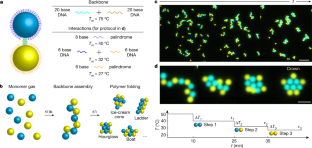S配管や人体内部など、手の届きにくい場所を移動できるソフトロボット。 oft robots can navigate hard-to-reach places like pipes or inside the human body
2022-09-28 ミネソタ大学
固形物の軌跡は曲がり角で引っ張るのが難しくなり、障害物や曲がりくねった道がある場所ではロボットが移動するのが難しくなる。
ミネソタ大学のチームは、材料を開口部から押し出して特定の形状にする「押出成形」という新しい手段を開発することで、この問題を解決した。この新しいプロセスを用いることで、ロボットは固体ではなく液体から合成材料を作ることができるようになった。
研究者たちは、光重合という技術を使って、このプロセスを合成材料で模倣することができた。光重合は、光を用いて液体のモノマーを固体材料に変化させる技術。この技術を用いることで、ソフトロボットは障害物や曲がりくねった道を、固形物を引きずることなく、より簡単に移動することができるようになった。
<関連情報>
- https://cse.umn.edu/college/news/engineers-discover-process-synthetic-material-growth-enabling-soft-robots-grow-plants
- https://www.pnas.org/doi/10.1073/pnas.2201776119
植物や菌類にヒントを得た自己潤滑性光重合と押し出しによる合成成長 Synthetic growth by self-lubricated photopolymerization and extrusion inspired by plants and fungi
Matthew M. Hausladen, Boran Zhao, Matthew S. Kubala, Lorraine F. Francis, Timothy M. Kowalewski and Christopher J. Ellison Published:August 9, 2022 PANS
DOI:https://doi.org/10.1073/pnas.2201776119

Significance
Growth in nature often couples material generation and actuation, offering an intriguing paradigm for the marriage of materials science and robotics. Inspired by the growth of plants and fungi, a new approach for synthetic materials growth was developed based on simultaneous self-lubricated photopolymerization and extrusion. This strategy enables a new continuous method for light-based fabrication of profiled parts not possible with state-of-the-art three-dimensional (3D) printing or other methods. We exploit this materials growth paradigm to produce a soft robot capable of rapid continuous growth, thereby addressing major limitations of growing soft robots that stem from limited extensibility, lack of permanent structure, and inability to negotiate torturous paths, demonstrating the potential of growth to provide new capabilities in manufacturing and soft robotics.
Abstract
Many natural organisms, such as fungal hyphae and plant roots, grow at their tips, enabling the generation of complex bodies composed of natural materials as well as dexterous movement and exploration. Tip growth presents an exemplary process by which materials synthesis and actuation are coupled, providing a blueprint for how growth could be realized in a synthetic system. Herein, we identify three underlying principles essential to tip-based growth of biological organisms: a fluid pressure driving force, localized polymerization for generating structure, and fluid-mediated transport of constituent materials. In this work, these evolved features inspire a synthetic materials growth process called extrusion by self-lubricated interface photopolymerization (E-SLIP), which can continuously fabricate solid profiled polymer parts with tunable mechanical properties from liquid precursors. To demonstrate the utility of E-SLIP, we create a tip-growing soft robot, outline its fundamental governing principles, and highlight its capabilities for growth at speeds up to 12 cm/min and lengths up to 1.5 m. This growing soft robot is capable of executing a range of tasks, including exploration, burrowing, and traversing tortuous paths, which highlight the potential for synthetic growth as a platform for on-demand manufacturing of infrastructure, exploration, and sensing in a variety of environments.
Proceedings of the National Academy of Sciences



 個人Zenith Aircraft CompanyCH701(自作航空機、複座)の重大インシデント[滑走路からの逸脱](長野市滑空場、令和3年7月5日発生)](https://tiisys.com/wp-content/uploads/2022/09/kozinsyozoku.png)